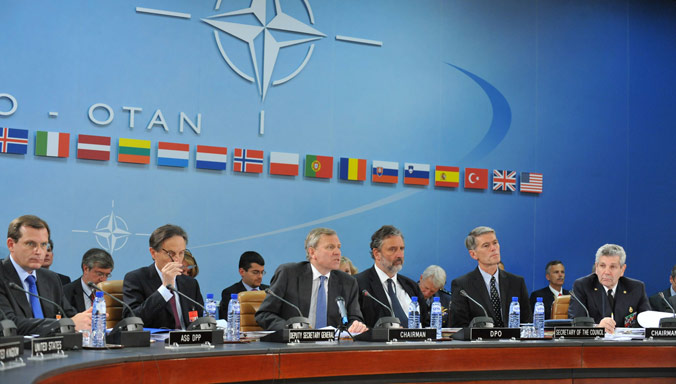Defence Planning Committee (1963-2010)
The Defence Planning Committee (DPC) was a senior decision-making body on matters relating to the integrated military structure of the Alliance. Created in 1963, it was dissolved following a major committee review in June 2010 and its responsibilities were absorbed by the North Atlantic Council.

- The Defence Planning Committee was the ultimate authority on all questions related to NATO’s integrated military structure.
- It provided guidance to NATO's military authorities and oversaw the force planning process.
- It had the same level of authority as the North Atlantic Council and the Nuclear Planning Group on matters within its competence.
- Between 1966 and April 2009, France was not represented on this committee as a consequence of its withdrawal from the integrated military structure.
-
Authority and responsibilities
The DPC was created in 1963 at a time when members were especially concerned about the need for a balance between the Alliance’s conventional and nuclear capabilities. When members directed the North Atlantic Council (Council or NAC) to review the issues of strategy, force requirements and available resources, the Council constituted itself as a ‘Defence Planning Committee’ to direct and supervise this review.
The DPC made its first report to the Council in December 1965, in response to a request for a five-year force goals plan (in that same month, the Council decided to base defence planning on a five-year cycle, complemented by yearly and triennial reviews). When France withdrew from NATO’s integrated military structure a year later, in 1966, the Council extended the DPC’s mandate beyond strictly military planning to include all integrated matters and all matters concerning bodies in which France no longer participated.
The DPC was responsible within the Alliance for all questions related to the Alliance's integrated military structure and had the same level of authority as the NAC and the Nuclear Planning Group on matters within their competence.
It implemented decisions taken by the participating countries in relation to collective defence planning and dealt with issues pertaining to the integrated military structure of the Alliance. It provided guidance to NATO's military authorities and oversaw the force planning process. The force planning process identifies NATO's military requirements, sets planning targets for individual countries to contribute to those requirements, and assesses the extent to which members meet those targets and provide other forces and capabilities to the Alliance. It also approved force goals and ministerial guidance for future NATO defence planning.
Although the DPC’s work focused on the integrated military structure and military and defence-related issues, the NAC also discussed some of these matters before entirely taking over the DPC’s responsibilities in 2010. Conversely, in 2003 at the outbreak of the Iraq crisis, the Council moved the decision to authorise NATO military authorities to implement defensive measures to assist Türkiye to the DPC. This was the result of a disagreement among member countries on whether deterrent and defensive measures should be initiated and, if so, at what point. Three member countries – Belgium, France and Germany – felt that any early moves by NATO could influence the ongoing debate at the United Nations Security Council with regard to Iraq and the effort to find a peaceful solution to the crisis.
On 16 February 2003, with the cohesion of the Alliance under strain, Lord Robertson, the then Secretary General of NATO acting in his capacity as Chair, concluded that no further progress on this matter could be made within the Council.
On the same day, with the concurrence of all member countries, the matter was taken up by the DPC. At the time, it was composed of all member countries, except France, which did not participate in NATO's integrated military structure. The Committee was able to reach agreement and on 19 February 2003 it authorised the military authorities to implement, as a matter of urgency, defensive measures to assist Türkiye under the name of Operation Display Deterrence.
-
Participants
Members participating in NATO's integrated military structure were represented on the DPC. As such, between April 2009 and June 2010, all member countries had a seat on this committee.
In the past, between 1966 and 2009, France was not represented on the DPC as a consequence of its withdrawal from the integrated military structure. However, at the Strasbourg/ Kehl Summit in April 2009, it officially announced its decision to fully participate in NATO military structures.
The DPC was chaired by the Secretary General of NATO.
-
Working procedures
As is the case for all NATO committees, decisions were taken by consensus within the DPC.
Its work was prepared by a number of subordinate committees with specific responsibilities. In particular, the Defence Review Committee, which was also dissolved in June 2010, coordinated the force planning process within NATO and examined other issues relating to the integrated military structure.
Similarly to the NAC, the DPC looked to the senior committee with the relevant specific responsibility for the preparatory and follow-up work arising from its decisions.
Within the International Staff at NATO Headquarters, the DPC was principally supported by the Defence Policy and Planning Division and the Operations Division.
The DPC used to meet, when necessary, at the level of ambassadors and twice a year at the level of ministers of defence.
